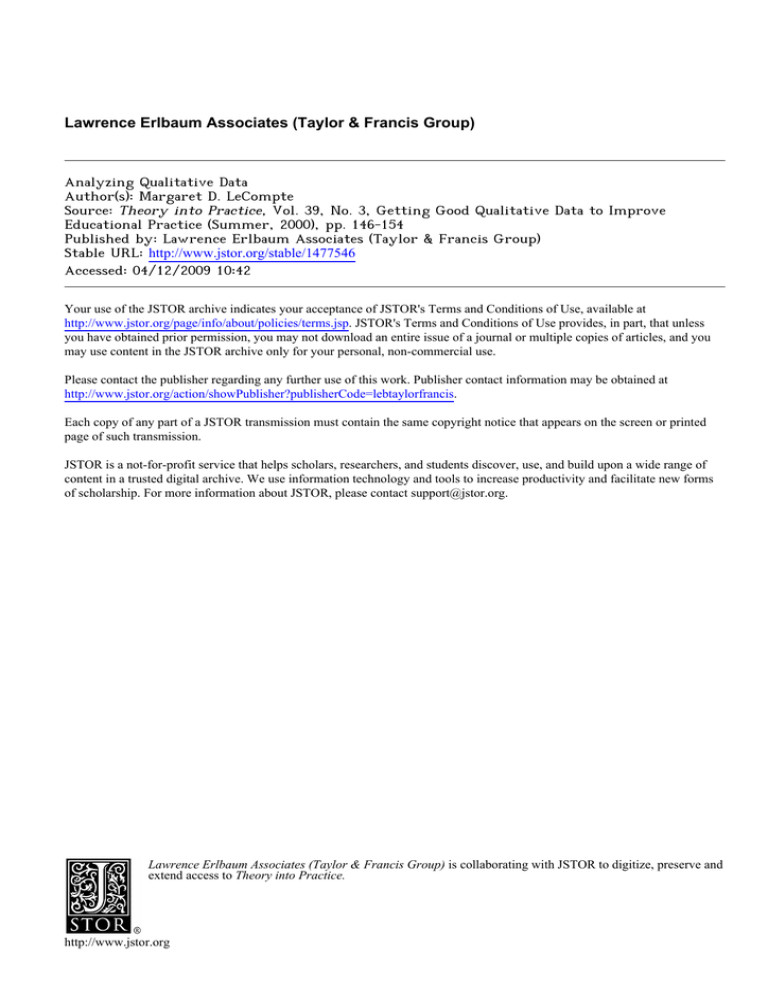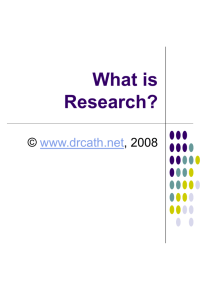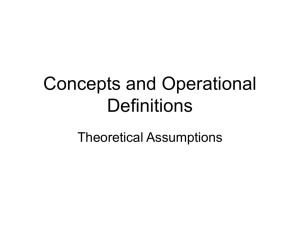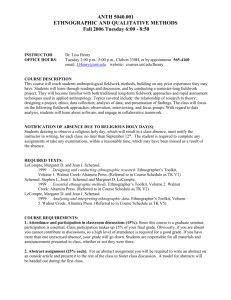Lawrence Erlbaum Associates (Taylor & Francis Group)
advertisement

Lawrence Erlbaum Associates (Taylor & Francis Group) Analyzing Qualitative Data Author(s): Margaret D. LeCompte Source: Theory into Practice, Vol. 39, No. 3, Getting Good Qualitative Data to Improve Educational Practice (Summer, 2000), pp. 146-154 Published by: Lawrence Erlbaum Associates (Taylor & Francis Group) Stable URL: http://www.jstor.org/stable/1477546 Accessed: 04/12/2009 10:42 Your use of the JSTOR archive indicates your acceptance of JSTOR's Terms and Conditions of Use, available at http://www.jstor.org/page/info/about/policies/terms.jsp. JSTOR's Terms and Conditions of Use provides, in part, that unless you have obtained prior permission, you may not download an entire issue of a journal or multiple copies of articles, and you may use content in the JSTOR archive only for your personal, non-commercial use. Please contact the publisher regarding any further use of this work. Publisher contact information may be obtained at http://www.jstor.org/action/showPublisher?publisherCode=lebtaylorfrancis. Each copy of any part of a JSTOR transmission must contain the same copyright notice that appears on the screen or printed page of such transmission. JSTOR is a not-for-profit service that helps scholars, researchers, and students discover, use, and build upon a wide range of content in a trusted digital archive. We use information technology and tools to increase productivity and facilitate new forms of scholarship. For more information about JSTOR, please contact support@jstor.org. Lawrence Erlbaum Associates (Taylor & Francis Group) is collaborating with JSTOR to digitize, preserve and extend access to Theory into Practice. http://www.jstor.org MargaretD. LeCompte Analyzing Qualitative Data ROGRAM ADMINISTRATORS AND TEACHERS collect all kinds of qualitative data-interviews, observations, documents. In order for such data to be useful in improving programs, solving problems, or explaining what happened, data must be turnedinto results.Transformingdatainto research results is called analysis. Big piles of data are transformedinto succinct statementsthatdescribe,explain, or predict something about what the researcher has studied (LeCompte & Schensul, 1999). Analysis is a bit like taking apart puzzles and reassembling them (LeCompte & Preissle, with Tesch, 1993). However, puzzles cannot be completed if pieces are missing, warped, or broken. Similarly, if pieces of data are incomplete or biased, research results cannot provide a complete picture of a program or a good solution to problems. A first step in analysis, then, is identifying sources of bias. Some Rules for Unbiased Data Analysis Good qualitative data are as unbiased as possible. However, because such data are collected by human beings, and because people are interested in certain things and not others, selections are made. People tend to record as data what makes sense to and intrigues them. Selectivity cannot be eliminated, but it is important to be aware of how it affects data collection, and hence, the usefulness and crediMargaret D. LeCompte is professor of education at the University of Colorado-Boulder. bility of research results. To develop such awareness, people collecting data should be aware of the effects of both tacit and formative theory. These are the sources of selectivity (and bias) because they create something analogous to a filter that admits relevant data and screens out what does not seem interesting-even if, with hindsight, it could have been useful. Tacit theories guide daily behavior,explain the past, and predict what will happen next. People rely on tacit theories to help them decide to carryumbrellas on cloudy days (theorizing that it might rain), or investigate when children act oddly (theorizing that they might be depressed, associating with undesirable peers, or doing drugs). Tacit theories also guide teachers' ideas about which children are good learners. Such theories could bias investigation if other kinds of children are overlooked. Formative theories also guide behavior, create explanations, and predict the future, but they are more formal, and found in research. As the basis for data collection and analysis, they generally derive from the disciplines in which researchers, program developers, and practitioners are trained. They guide development of research questions, ideas about what data to collect, and which units of analysis should be used in investigations. LeCompte and Holloway (1997) built their study of an intensive middle-school arts program around discipline-based theories suggesting that if THEORYINTO PRACTICE, Volume 39, Number 3, Summer 2000 Copyright ? 2000 College of Education, The Ohio State University 0040-5841/2000$1.50 LeCompte Analyzing Qualitative Data teachers and children had opportunities to observe, talk about, and engage in behavior that differed from traditionalgender and occupational roles, they might define their own identities in novel ways. These formative theories (Schensul, Schensul, & LeCompte, 1999) were based on theories about gender and identity in sociology (Goffman, 1959, 1960), activity theory in psychology (Vygotsky, 1978), and anthropologicalnotions of culturaltransmission (Bourdieu, 1993; Bourdieu & Passeron, 1977). They influenced what the researcherslooked for while observing and recording data, especially during teacher-pupil interaction and interviews. Later, they created the large conceptual categories into which raw data were sorted for preliminary analysis (see discussion of Vadeboncoeur's use of such conceptual categories later in this article). Tacit theories are identified to avoid bias in data collection, analysis, and interpretation. Formative theories are identified to develop research questions and guide data collection and initial analysis (Schensul, Schensul, & LeCompte, 1999). Thus, researchers must make both tacit and formative theory clear and then delineate their role in data collection. Having done that, analysis can begin. Thinking About Analysis Thinking of analysis as assembling a jigsaw puzzle is helpful. Jigsaw puzzles cut up a whole picture into fragments. Van Gogh's painting, "Crows Over a Wheatfield," has a golden wheatfield at the bottom, above which is sky, ranging from light blue near the wheatfield to nearly black at the top. Stylized crows fly through the darkening sky. To assemble a jigsaw puzzle of this painting, people might: -Put all the similar pieces (all the edges, or the blue sky pieces, or those that might be parts of the wheatfield) in piles, then -Assemble the sky chunks, the wheatfield chunks, and the outside borders, and finally, -Identify the linking pieces so that the big chunks can be tied together into a coherent facsimile of the painting. Players can "cheat" by stealing a glimpse of the picture of the painting on the puzzle box, just as researchers can get some idea of their research findings by looking at research done by other peo- ple on the same or similar subjects. But even the completed picture reveals little about the real meaning of the painting. It presents nothing of the personal or cultural meaning of the piece of art it represents:that it is the last picture Van Gogh painted before committing suicide; that it represents a dramatic break from current artistic traditions; that the artist never sold a single painting during his lifetime. It also says nothing about the social and cultural standing of European artists in the late 19th century. Making such statements requires interpretation, which is beyond the scope of this article (see LeCompte & Schensul, 1999). The task of analysis, which makes interpretation possible, requires researchers first to determine how to organize their data and use it to construct an intact portrait of the original phenomenon under study and second, to tell readers what that portrait means. Countable data, such as test scores or the number of males and females or persons of different ethnic affiliation in a group, are relatively easy to analyze by feeding them into a computer program for "analysis." Computers manipulate data mathematically to count items, display variance, and identify relationships between characteristics. Unfortunately, qualitative data sets are more complex and ambiguous than test scores. Less straightforward qualities such as "sexual orientation," "coping skills," "depression,"or "resilience" are not always defined clearly and cannot always be measured with pre-existing instruments. Clearly, educators faced with increasing violence in schools have not defined key qualities that explain its cause or devised ways to measure them. They first must find out how teenagers (as well as parents and other relevant adults) define such problems and issues of violence, learn what students say causes the initial stages of violent behavior and what they look like, and devise ways to measure them by collecting qualitative data. Because these kinds of data have no initial intrinsicorganizationalstructureor meaningby which to explain the events under study, researchers(or in this case, educators)must then create a structureand impose it on the data. The structure is created in stages, and forms the basis for assembling data into an explanation or solution. Creating the structureis analogous to the strategies used to assemble puzzle 147 / Summer 2000 INTOPRACTICE THEORY GettingGood QualitativeData pieces; the pieces are like units of analysis in the data. Both are assembled using specific rules, except that in research,the rules set out how data are assembled to answer researchquestions. Doing Analysis one: tidying up Step The first step in analysis is "tidying up" (Romagnano, 1991). Researchers may think that the time they spend arranging data in neat boxes and files is wasted. However, tidying up is an absolutely necessary first step to coding and analyzing data. Tidying up involves the following: 1. Make copies of all data. 2. Put all field notes and interviews into a file in order of their dates of creation. 3. Create other files based on type of data (e.g., interviews, questionnaires, field notes, artifacts), participants (e.g., data separated into files for students, teachers, staff development workers, parents), or organizations (e.g., data separated into files for health agencies, foundations, schools, labor unions, and clinics), subject or topic (e.g., data separated according to materials on recruitment of students, recruitment of teachers, parent involvement, curriculum characteristics, school board politics). The files to be created depend completely on what is reasonable and necessary, given the research questions. 4. Catalog and store all documents and artifacts. 5. Label all files and boxes according to their contents. 6. Create an index or table of contents for all data. 7. Review research questions, comparing them against the data collected. 8. Identify any holes or missing data chunks by determining if data actually were collected to answer each research question. 9. Returnto the field to collect additionaldata to fill gaps in the record. Holes in the record sometimes cannot be avoided. Data initially thoughtdesirable may turn out to be unnecessary;or collecting it may be too difficult, expensive, or dangerous.If the latter, then researchersmust develop a rationale for why missing data cannot or will not be acquired. 148 Tidying up permits researchersto make a preliminary assessment of the data set. The next step in analysis involves finding items. Step two: finding items Items are the specific things in the data set that researcherscode, count, and assemble into research results. In this article, they will be called items or units of analysis. Finding items in data sets resembles sifting and sorting, somewhat analogous to sifting flour to remove weevils. At first, the flour may appear quite acceptable, but sifting it concentrates the weevils so that they appearin the remainingraw flour. Data are sifted by repeated readings through field notes, interviews, and text to identify items relevantto the researchquestions.Concentratingthese items in data involves systematic processes of looking for frequency, omission, and declaration. Frequency. Items sometimes can be identified because they are numerous. Data might show that high school seniors in their final semester often are late or absent without excuses. Tardiness and truancy could then be identified as items in a study of alienation from school. Omission. Items also can be identified because never they appear, even though researchers might it think reasonablethat they would. LeCompte(1974, 1978), for example, thought it reasonableto look for behaviorused by teachersto stress the intrinsicvalue of learning. However, in a year of observing four different fourth grade teachers, that behavior never appearedonce-a fact LeCompte thought important, even though it involved the absence, ratherthan the presence, of a phenomenon. Declaration. Items sometimes are identified as present or significant by study participantswho tell researchers they exist. For example, teachers in a Learning Circle program told researchers that they always made appointments before visiting parents (LeCompte,Aguilera, Wilks, Fordemwalt,& Wiertelak, 1996). Researchersthen must verify whether or not the items really do exist in the data, and if not, why not, even though participantssay they do. Step three: creating stable sets of items Once initial items have been identified, researchersmust organize them into groups or categories by comparing and contrasting items (Glaser & LeCompte Analyzing Qualitative Data Strauss, 1967), or mixing and matching them, somewhat like the reading readiness tasks in workbooks that elementary school children use to compare and contrast like and unlike objects. The purpose of these activities is to clump together items that are similar or go together. Researchers look for things that are exactly alike, things that differ slightlytherefore modifying initial descriptions-or things that either differ a great deal or negate one another, all so that clear-cut distinctions can be made between different kinds of items. Using meaningful criteria or rules helps make these comparisons easier. Such rules can be created just for the study, or a set of guidelines can be used, such as Spradley's (1979) semantic relationships, displayed in Figure 1. Spradley's list fits any culture or situation. Items in a data set can be substituted into the phrases in it so as to organize them into sets of like and unlike items. 1. X is 2. X is 3. X is 4. X is 5. X is 6. X is a kind of Y a place in Y a part of Y a result of Y a cause of Y a reason for Y 7. X is a place for doing Y 8. X is used for Y 9. X is a way to do Y 10. X is a stage or step in Y 11. X is a characteristicof Y 12. X is a place for doing Y Figure 1. Spradley's semantic relationships. For example, substituting the names of individual items for the "X" in Spradley's phrases, and the names of potential categories of items for the "Y" (e.g., "vocational training is a kind of education," "high school is a stage in education," "libraries are a place in schools," "theater arts is part of the arts curriculum")permits researchers to identify and clarify description of items systematically. The resulting lists constitute a taxonomy, category, or classification scheme. Below are presented several examples of how items might be identified within a given data set. Assembling a taxonomy. Suppose an anthropologist began asking informants to show her what they ate. After looking at and tasting various foods, she might notice that informants repeatedly showed her things that tasted sweet. Table 1 illustrates how she might display the things (items) that tasted sweet, using the semantic relationship, "X is a kind of [sweet]." Table 1. a Identifying Taxonomy of Items Using "X is a kind of Y" IndividualItems(X's) Chocolate Lollipops Taffy Raisins Candiedfruit Honey TaxonomicName (Y) Sweets These initial groups could be subdivided further: "Sweets" could be divided into naturally occurring sweets, such as fruits and honey, and those that need processing, such as lollipops, chocolate, or taffy. They also could be divided into sweets that are hard, soft, or liquid; arranged by color, shape, and size; or categorized in order of preference by the local people or by their nutritional value, price, or scarcity. How they were divided would depend on what the anthropologists were studying (general consumption, nutritional habits, or food preferences) or what people choose to tell her (females may not be permitted to eat some kinds of sweets) or share with her (chocolate may be very scarce, and local people may not want her to have any). In addition, local people might describe as "sweet" some foods that do not taste sweet at all to western anthropologists-such as sea urchins or nuts. The constituent items for another taxonomy were noticed in a study of the Learning Circle Project, an enrichment program for urban American Indian elementaryschool children (LeCompteet al., 1996). Learning Circle is a program for urban American Indian students in kindergartenthrough grade 3. It operates as an after-school language arts and social studies enrichment program, and includes both home visitations and a resource library from which parentscan borrow educationalresources to use at home with their children. Table 2 shows a set of behaviors with regard to parents whose occurrence was frequently noted in interviews with parents and teachers, as well as in field notes of observations. These were radically different behaviors from those usually experienced by low-income people 149 THEORYINTO PRACTICE/ Summer 2000 Getting Good Qualitative Data Table 2 A Taxonomy of Items From the Learning Circle, Developed Using "X is a Way to [Respect Parents]" TaxonomicName (Y) Items(X's) Respectingparents Contacting them in advance for meetings Sending certified teachers, not social workers,on home visits Providing a meal or refreshmentsat parentmeetings Asking for parents' input on curriculumandactuallyusingit of color when interacting with public school programs. Parents said never before had school persoinnel made appointments for home visits, and never before had "real" teachers come to their homes. Parents were encouraged to provide ideas for the curriculum, and those ideas were incorporated into lesson plans. In keeping with American Indian norms that important events should be accompanied by sharing food, the significance of Learning Circle parent meetings was marked by their association with substantial refreshments or a potluck dinner. Taken together, these items created a taxonomy that the researcherscalled "Respecting Parents." Constructing sets of taxonomies. Other taxonomies also began to emerge, consisting of individual items of behavior and belief, just as "Respecting Parents" did. Each of these taxonomies was constructed using large sheets of butcher paper and self-stick notes. Taxonomic names were written on each sheet, and then each data set was sifted through for relevant items (e.g., a sheet for all the ways of respecting parents from teacher interviews, all the ways of respecting parents found in observations, all the ways mentioned in parent interviews, all the items found in program documents). The items were written on notes and moved around until their location within a taxonomy was confirmed. Using research participants to create taxonomies. Research participants can help investigators sort data into meaningful sets. A useful sorting strategy is called the "pile sort" (Borgatti, 1999). 150 Pile sorts involve writing down on cards the names of (or providing unambiguous pictures for) each of the items to be sorted, giving the deck of cards to research participants, and asking them to sort the cards into sets that "go together." Pile sorts permit researchers to determine how the people they are studying assemble items, rather than relying on researcher categories alone. Conducting data collection strategies such as these, using them to create the "rules" for identifying items and creating taxonomies, helps to assure that the researchers' categories are meaningful to the people studied. If researchers studying food, for example, selectively ignore those products they do not think are sweet, or fail to include them among items grouped together by the local people as sweets, they may fail to develop a full taxonomy of delectables defined as the local people see them. This would be a source of bias in the data, one resulting from the researchers' unexamined tacit theories about what is tasty. Similarly, studies relying on behavior identified by adults as problematicto identify potential teen suicides might miss those teenagers find more important as sources of alienation and despair-with concomitant programmaticfailure to arrest a serious social problem! Step four: creating patterns After stable taxonomies of "things that go together" are created, patterns need to be identified. Identifying patterns involves seeing how taxonomies can be clumped together in meaningful ways. Patternsare made up of taxonomies that seem to fit together or be related to one another.The process is analogous to linking all the sky pieces in the Van Gogh jigsaw puzzle together with the bird pieces, so that the whole picture begins to emerge. Collecting data and finding items involves taking things apart and identifying their constituent parts. Locating patterns involves reassembling them in ways that begin to resemble a coherent explanation or description of the program, event, or phenomenon under study. Because it establishes the regularities within a cultural scene, identifying the most important patterns can help to clarify key ways to solve problems in a program or begin creating explanations for what happened during its duration. LeCompte Analyzing Qualitative Data Assembling patterns involves looking for some of the same characteristics that were used to identify items-such as frequency of occurrence, omission, and declaration-as well as looking for: -similarity and analogy, or sets of items that are identical or serve the same purposes (students who drink often use drugs as well, because both drugs and alcohol make them high); -co-occurrence, or sets of things that occur at the same time or place (students who smoke often drink as well); -sequence, or groups of things that appear in series, usually temporally (girls who get pregnant drop out when their transportation or childcare arrangements fail); -hypothesized reasonableness or patterns researchers think should exist, based on prior research, experience, or hunches (children who exhibit sudden shyness, hostility, and/or unexplained bruises and injuries may be abuse victims), and -corroboration or triangulation, or patterns whose existence is confirmed by other pieces of data or information (observations of students smoking in stairwells, confirmed by interviews with students identifying stairwells as smoking venues). Researchers assemble patterns by looking at each set of data, asking of it the same kinds of questions. In a study of an arts enrichmentprogram, for example, LeCompte and Holloway (1997) asked, "How is the concept 'being an artist' manifested in a) studentinterviews, b) teacherinterviews, c) school documents, d) classroom observations?"They also asked, "To what extent is art skills training evident in a) student interviews, b) teacher interviews, c) classroom observations, d) program documents, e) student products?"Answers to those questions were then triangulated, or compared and contrasted, across data sets. When it became clear that "being an artist" was emphasized frequently, in many ways, and across data sets, the researchers could confirm that it constituted a pattern in the study site, just as "respecting parents" was a pattern in the Learning Circle. Step five: assembling structures Once patterns have been identified, groups of them are then assembled into structures, or groups of related or linked patterns that, taken together, build an overall description of the program or problem being studied. If the data are good and analysis skillfully done, such descriptions can help participants see more clearly how to solve problems, improve programs, assess their effectiveness, or develop theories explaining what happened. To summarize: In the item stage of analysis, researcherscreate taxonomies of "things"at different levels of abstraction.To the extent that these taxonomies are pervasive, they are grouped into patternsin the patternstage of analysis. In the structuralstage, patterns are grouped into structures,which help to describe or explain the whole phenomenon. In the Learning Circle, a series of patterns were linked together in a structure that explained why the program was uniquely reflective of American Indian cultures, and pointed to steps other such programscould take to become more effective. Figure 2 displays in two columns the several patterns which, taken together, created a structure called "Privileging Indian Culture." RespectingIndianparents Providingchoices + HiringIndianteachers + MakingLearningCircle rigorous + + Creatinga safe place to be Indian + PrivilegingIndiancultural knowledge Figure 2. Patterns assembled to create a structure called "Privileging Indian Culture" in the Learning Circle data. Each of the six patterns in Figure 2 consisted of taxonomies of related items. There were, for example, several different taxonomies of items that denoted "ways of respecting parents" and "creating a safe place for Indian children." Concretely, Learning Circle teachers all were certified or licensed teachers (an item), and they all were American Indians (anotheritem). These teachers believed Indian children should feel no stigma in identifying as Indians and celebrating their tribal heritages (two more items)-including mixed Indian and European or Mexican background. Learning Circle also never forced students or parents to engage in activities they felt were culturally inappropriate(an item). An emphasis on choice of activities (another item) facilitated celebrating multiple heritages (an item) while still being true to American Indian 151 THEORYINTO PRACTICE/ Summer 2000 Getting Good Qualitative Data norms respecting the dignity of individuals. Each of these taxonomies was grouped with related patterns. Taken together, the six patterns in Figure 2 created a structureby which researchers characterized Learning Circle. They considered this structure, "Privileging Indian Culture," to be one of the principle reasons Learning Circle was such a success with participants. Other important indicators of success were structures demonstrating academic achievement, expansion of the program to upper grades, and increased program enrollment. Assembling structures-or analysis leading to the creation of structures-such as "privilegingIndian culture," involves a laborious process of cutting and pasting, mixing and matching, triangulating,and assembling, similar to that used in creating taxonomies and patterns. Structuralanalysis also is facilitated by creating graphics. Miles and Huberman (1984) suggest thatresearchersreally know only what they can display visually. Doodling is one way to begin creating displays, by creating diagrams, conceptualmaps, taxonomictrees, flow charts,and causal maps to display relationshipsamong patterns. Another strategy involves developing rough conceptual categories, such as those Vadeboncoeur (1998, p. 148) used for her longitudinal study of attitudinal change among students experiencing an innovative teacher training program (see Figure 3). Vadeboncoeur's data consisted of interviews with students, students' journals, field notes taken while observing students in their classes and during student teaching, and interviews with professors teaching the classes. Concepts stressed in the program were forms of evaluation using the students' own personal experiences ("understandingthe self'), their relationshipswith other people ("understandingother people"), and their understandingsof social, economic, and political structure ("understanding the environment") as bases for judgment. These bases roughly corresponded to Freire's (1970) notions of semi-intransitive, transitive, and transformative forms of consciousness-concepts emphasized heavily in the teacher training program. Vadeboncoeur went through all her data sets, sorting all material relating to "self," "self in relation to other people," and "self in relation to the environment" into separate piles. After this rough 152 sorting procedure, she then examined each separate pile, looking for items, patterns, and structures within each one. Later she could look at how students changed over time with reference to each individual pile and then compare across the piles to look for evidence of growth or changes in level of consciousness. Structural analysis often begins with such handwrittendiagrams.These then can be transferred to a neater, computerized version. Such graphic representations may closely match the way informants think or create linkages. They can be used as preliminary sketches from which to solicit informant feedback. Making Sure Data is Credible and Useful Analysis that is meticulously done, based on clearly articulated theories, and responsive to research questions can be good analysis. However, to create good research findings, analysis also must yield results that are meaningful to the people for whom they are intended and described in language they understand. Unless this is done, results cannot be used to improve programs and practice or solve problems in which participants are interested. Creating meaningful results involves validity, or whether or not research findings seem accurate or reasonable to the people who were studied. It also refers to whether or not results obtained in one study can be applied to other studies with similar or identical people or situations. Validity is critical to the "goodness" of analyzed data, because no matter how elegant a researcher's own model building is, results lack credibility, utility, or validity if the cultural whole presented by the researcher makes no sense to the persons or groups whose cultural whole is, in fact, being portrayed. Therefore, researchers must continually ask the question: Do I, the researcher, really understand and describe what I am studying in the same way that the people who live it do? Did I really "get it right"? Just as researchers should solicit input from local participantsto make sure that they have properly identified and classified items, they also must seek input once they have achieved a more or less coherent structuralanalysis. Key people in the research site can assess whether or not the relationships and LeCompte Analyzing Qualitative Data the "self' in relation to the "environment" the "Environment, / nderstanding * througheconomic, political, cultural,sociological lenses * recognizingsocial structuresand influences such as institutionalized classism, racism, sexism (everydayandacademicknowledge) the "self' in relationto "otherpeople" "otherpeople"in relation to the "environment" Figure 3. A model of emancipatory knowledge construction (Vadeboncoeur, 1998, p. 148). 153 THEORYINTO PRACTICE/ Summer 2000 Getting Good Qualitative Data patterns displayed are ones they also recognize as valid. If they are not, the research results will be neither intelligible nor useful. By contrast, if local people think the results make sense, they will be able and willing to use the analyzed data to improve their practice and programs. Researchers then can feel comfortable with the "goodness" of their analytic strategies and the credibility and utility of their efforts. References Bourdieu, P., & Passeron, J. (1977). Reproduction in education, society and culture. Beverly Hills, CA: Sage Publications. Bourdieu, P. (1993). The field of cultural production. New York: Columbia University Press. Borgatti, S.P. (1999). Elicitation techniques. In J.J. Schensul, M.D. LeCompte, B.K. Nastasi, & S.P. Borgatti (Eds.), Enhanced ethnographic methods (pp. 115-151), book three of The Ethnographer's Toolkit, J.J. Schensul & M.D. LeCompte (Eds.). Walnut Creek, CA: Altamira Press, a division of Sage Publications. Freire, P. (1970). Pedagogy of the oppressed. New York: Herder & Herder. Glaser, B., & Strauss, A.L. (1967). The discovery of grounded theory: Strategies for qualitative research. Chicago: Aldine. Goffman, E. (1959). The presentation of self in everyday life. New York: Viking. Goffman, E. (1960). Asylums. New York: Viking. LeCompte, M.D. (1974). Institutional constraints on teacher styles and the development of student work norms. Unpublished doctoral dissertation, Department of Education and the Social Order, University of Chicago. LeCompte, M.D. (1978). Learning to work. Anthropology and Education Quarterly, 9, 22-37. LeCompte, M.D., Aguilera, D., Wilks, S., Fordemwalt,B., & Wiertelak,M.E. (1996). Final reportfor the Learning Circle, Osbor School District,Phoenix, AZ. LeCompte, M.D., & Holloway, D.L. (1997). First year report for the Arts Focus Program, Centerline Middle School, Mountain States School District (pseudonyms). LeCompte, M.D., & Preissle, J., with Tesch, R. (1993). Ethnography and qualitative design in educational research (2nd ed.). San Diego, CA: Academic Press. LeCompte, M.D., & Schensul, J.J. (1999). Analyzing and interpreting ethnographic data. Book Five of The Ethnographer's Toolkit, J.J. Schensul & M.D. LeCompte (Eds.). Walnut Creek, CA: Altamira Press, a division of Sage Publications. Miles, M.B., & Huberman, A.M. (1984). Qualitative data analysis: A sourcebook of new methods. Beverly Hills, CA: Sage Publications. Romagnano, L.S. (1991). Managing the dilemmas of change: A case study of two ninth grade general mathematics teachers. Unpublished doctoral dissertation, University of Colorado, Boulder. Schensul, S., Schensul, J., & LeCompte, M.D. (1999). Essential ethnographic methods. Book Two of The Ethnographer's Toolkit, J.J. Schensul & M.D. LeCompte (Eds.). Walnut Creek, CA: Altamira Press, a division of Sage Publications. Spradley, J.P. (1979). The ethnographic interview. New York: Holt, Rinehart & Winston. Vadeboncoeur, J. (1998). Emancipatory knowledge construction in teacher education: Developing critically conscious roles through metaphor and service learning. Ann Arbor, MI: UMI dissertation Services. Vygotsky, L. (1978). Thoughtand language. Cambridge. MA: Massachusetts Institute of Technology Press. lip 154







